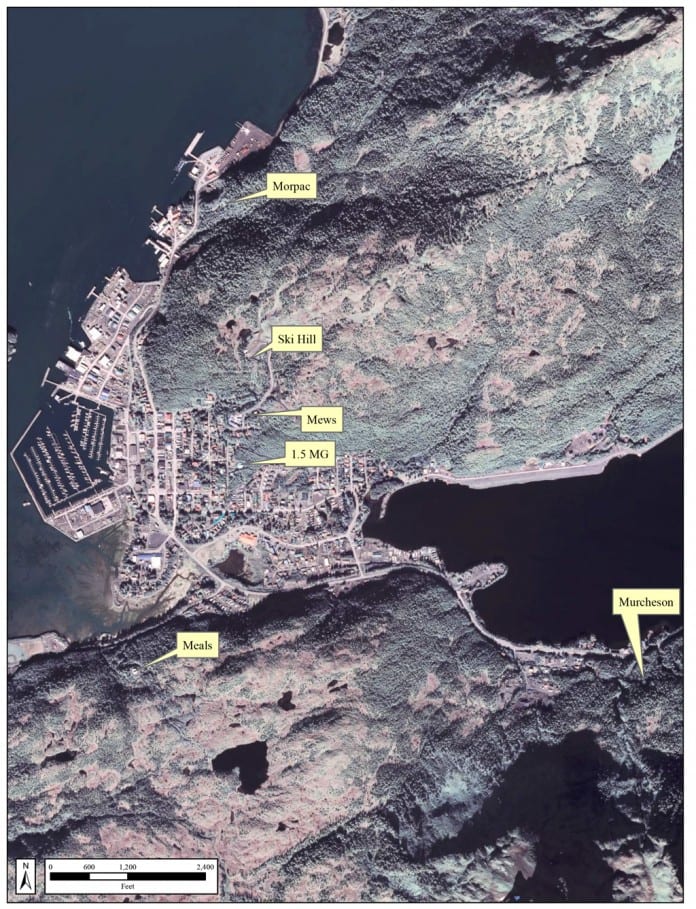
Each and every morning as Cordovans start their day they turn the faucet on and out comes clean, refreshing water. Ever think about what is involved in delivering that water to the convenience of your kitchen or bathroom? More than you can imagine.
Over its 100 years of incorporation, Cordova has developed, operated and continued to improve the delivery of water to a community blessed with an abundance of the liquid gold. In Cordova, not only is water essential to our personal well being but also a necessity to our biggest industry – the processors.
A network of underground pipes, originally wooden stave pipes wrapped in wire, then cast iron pipes are now modern copper and ductile iron pipes residing under our streets and landscape. Six large tanks strategically placed around the community serve as storage and sources to disperse the water we all need to our homes and businesses.
The oldest tank is the 1.5-million-gallon tank located on 5th Street, (commonly referred to as the 1.5 tank). This tank provides water to the Mews tank (near Mews apartments on the ski hill road) via a pump. The Mews tank provides water via a pump to the ski hill tank.
The Heney Reservoir on Whitshed Road stopped by an earth and rock fill provides water via gravity feeds to Meals tank to be chlorinated and stored for contact time with the chlorine. From there the water is dispersed across the city.
The 1.5M tank is the first to be worked on in this post LT2 phase. In early April, the tank was drained and the water utilized. Once the water was gone what remained was a 90’diamter, one-foot thick chunk of solid ice remained and during one week a crew of six from the Water Division and the Contractor chipped and moved 190 tons of ice!!
Once completely emptied and dried out the inspection and work began. DAMA, the subcontractor for Udelhoven (UOSS) and the City of Cordova inspected the tank as it was cleaned. At least one pit at the chine (where the base steel meets the vertical steel of the sides is about ten inches long and will need welded patches.
A robot and a crew member work together to sandblast the interior of the tank and are removing two layers of coating that have been on the tank for 30+ years. The crew will use approximately 60 tons of sand completing the four tanks for the City. Supersacks of sand reside at the AML dock so you may see DAMA moving them to the job sites. A robot is used on large open surfaces and two manual sandblasters are working on the roof joist and irregular steel supports.
In recent years, the Environmental Protection Agency has placed more stringent rules on the process of guaranteeing water is safe for human consumption. While, Cordova’s sources are some of the purest, the city’s Water Division was obligated to comply and began the work to become LT2 compliant.
The Alaska Department of Environmental Conservation provides communities the opportunity to compete for low interest loans for infrastructure upgrades. The first LT2 loan was requested by the city in March of 2013 for $1.081 million with $811,000 forgiven. This loan was dedicated to the installation of UV radiation to treat the community’s water at the three pump locations and rid the water of the possibility of cryptosporidium.
The work now being completed is all Post LT2. A second loan for that work was approved by Cordova voters in March 2016 for $3 million, with $1.2 million forgiven. Both loans are from the Alaska Department of Environmental Conservation under the Alaska drinking water loan. A grant was received in conjunction with the loans for $3,775 million with a match of 30 percent and the loans were used for that.
The remaining balance will be charged an interest rate of 1.5 percent, so the city can borrow $3 million and only have to pay back about $2 million.
The loan will enable the city to update and improve a variety of infrastructure needs to include SCADA (supervisory control and data acquisition) systems which are made up of hardware and software that controls and monitors our drinking water plants, actuated valves, etc. The system is for process control and for gathering data in real time from remote locations to control equipment and conditions.
Upgrades and new SCADA systems will allow the Water Department to more efficiently run all water processes. SCADA also records and logs all events into a file stored on a hard disk, which is used for periodic reporting. Variable frequency drives will be purchased for pumps providing increasing efficiency and reducing cost. Also, a Water Network Evaluation may be completed to improve and remove choke points in the gravity fed city water piping system, identifying areas where improvements in efficiency and cost savings can be implemented. Much of the city’s current water infrastructure is at least thirty years old.














